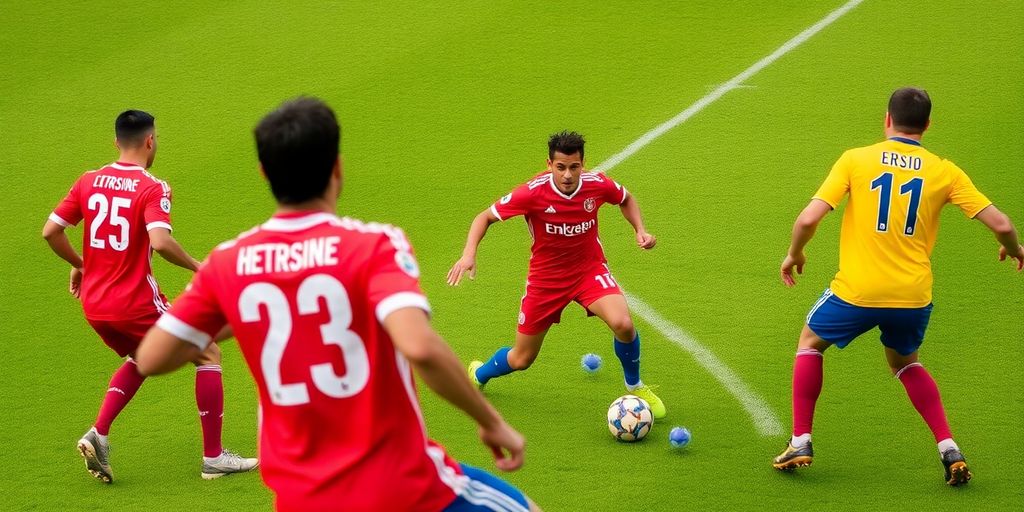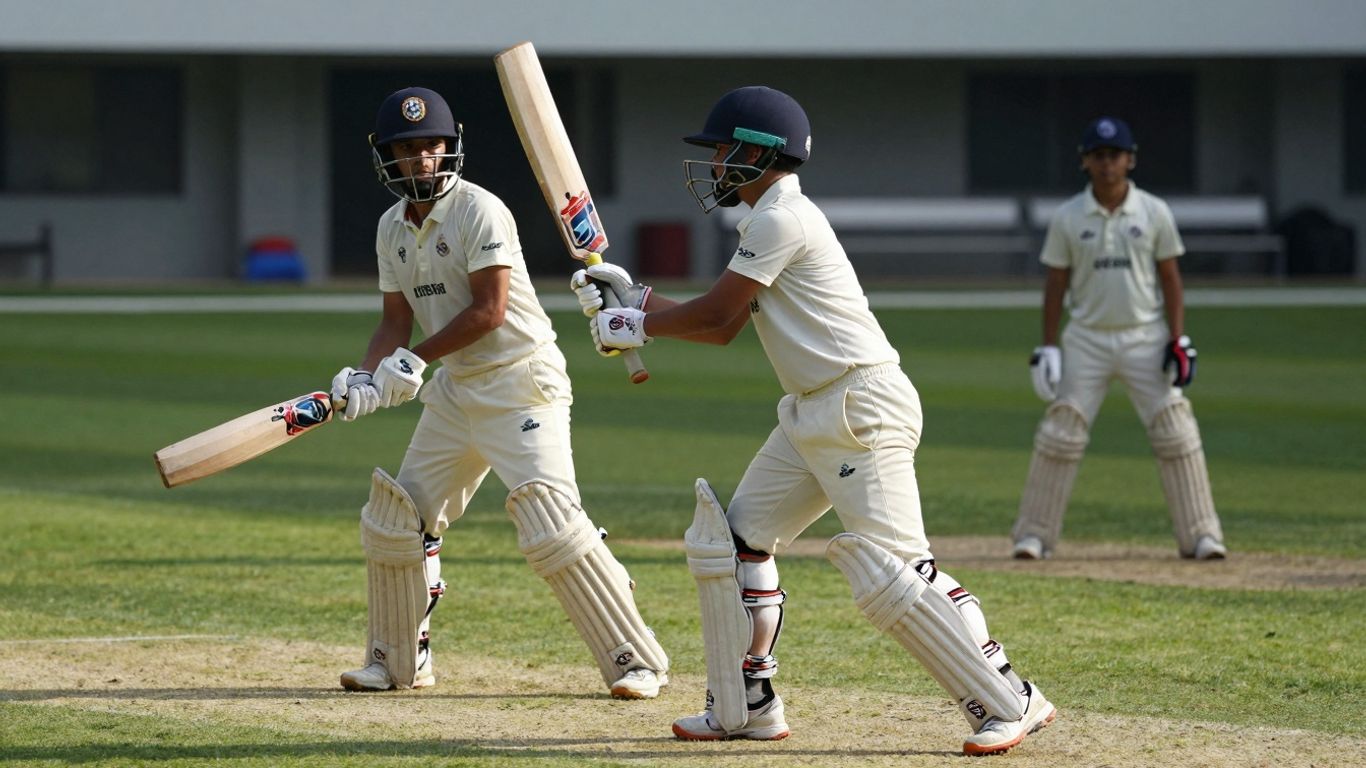If you’re a fan of soccer in Australia, you’ve probably heard about the offside rule but might still find it a bit confusing. This rule is one of the most talked-about aspects of the game, often leading to heated debates among fans and players alike. In this guide, we’ll break down the offside rule in simple terms, helping you understand its nuances and how it affects the game.
Key Takeaways
- Offside occurs when an attacking player is ahead of the last defender when the ball is played to them.
- A player can be in an offside position but not penalised if they are not involved in the play.
- The offside rule is judged at the moment the ball is kicked, not when the player receives it.
- Different game scenarios, like counter-attacks and set pieces, can change how offside is interpreted.
- In Australia, the offside rule is crucial in both local leagues and at the national level, influencing how the game is played.
Understanding The Offside Rule

Definition of Offside
Right, let’s get this straight. The offside rule in soccer can seem like a real head-scratcher, but it’s actually pretty simple once you get your head around it. Basically, a player is in an offside position if they are nearer to the opposition’s goal line than both the ball and the second-last opponent (usually a defender, but it could be the goalie if they’ve come way out of their net). It’s all about preventing players from just hanging around near the goal waiting for an easy pass. It keeps things fair and makes the game more interesting.
Key Components of Offside
There are a few things you need to keep in mind to fully understand offside. It’s not just about being in an offside position; it’s about becoming involved in active play while in that position. Here’s a quick rundown:
- Position: As mentioned, being closer to the goal line than the ball and second-last defender.
- Involvement: Interfering with play, interfering with an opponent, or gaining an advantage by being in that position.
- The Moment: The offside position is judged at the moment the ball is played by a teammate, not when the player receives the ball. This is a big one that trips people up.
- Halfway Line: A player can’t be offside in their own half. They must be on the attacking side of the halfway line.
Common Misconceptions
There are a few common myths about offside that need busting. One of the biggest is that if a player is in an offside position, they’re automatically offside. That’s not true! They only become offside if they then get involved in the play. Another misconception is that the position of the player is judged when they receive the ball. Nope, it’s all about where they are when the ball is played to them. And finally, some people think you can be offside from a goal kick, corner kick, or throw-in – you can’t. It’s worth understanding offside position to avoid confusion.
The offside rule is there to stop players from goal-hanging. Imagine if strikers could just stand right in front of the goal all the time – it would be a pretty boring game, wouldn’t it? It encourages teamwork, good passing, and clever tactics. It’s a key part of what makes soccer the game we love.
Determining Offside Position
Right, so you reckon you’ve got the basics of offside down pat? Good on ya! But knowing the rule is only half the battle. Figuring out when a player is actually offside can be a bit tricky, even for seasoned A-League fans. It’s all about timing and positioning, and how those things impact the play.
Positioning of Players
Okay, so first things first: where are the players on the pitch? An attacker is in an offside position if they are nearer to the opposition’s goal line than both the ball and the second-last opponent (usually a defender, but it could be the goalie if they’ve come way out of their box). Being in line with the second-last defender means you’re onside. Keep in mind that the halfway line matters too; you can’t be offside in your own half. It’s all about gaining an unfair advantage in the opponent’s territory.
Timing of the Ball
This is where things get interesting. It’s not enough to just be in an offside position. The offside call is made at the exact moment the ball is played by a teammate. So, an attacker might start their run from an onside position, but if they drift into an offside position before the ball is kicked, they’re offside. Conversely, they could start in an offside position and then come back onside before the ball is played – in that case, they’re fine. It’s all about that split-second timing. This is why you see players making those darting runs, trying to time their movement perfectly.
Impact on Play
Even if a player is in an offside position when the ball is played, they’re not automatically penalised. They only get pinged if they become "involved in active play". What does that mean? Well, it could be:
- Receiving the ball.
- Interfering with an opponent (like blocking their run or distracting them).
- Gaining an advantage by being in that offside position.
Basically, if the offside player isn’t doing anything to affect the game, the ref will usually let it go. But if they suddenly become a threat, then the flag goes up. It’s all about preventing players from just lurking near the goal, waiting for an easy tap-in. The soccer formations are designed to prevent this.
So, there you have it. Positioning, timing, and impact – the three key ingredients for determining offside. Keep an eye on these factors during the next A-League match, and you’ll be spotting those offside calls like a pro!
Consequences of Being Offside
Free Kicks and Penalties
When a player is caught offside, the most common consequence is a free kick awarded to the opposing team. This free kick is taken from the spot where the offside offence occurred. It’s an indirect free kick, meaning a goal can’t be scored directly from it – another player has to touch the ball before it enters the goal. Penalties are not usually awarded for offside, as offside is not a foul that occurs within the penalty area. The 5-3-2 soccer formation can be affected by offside calls.
Referee’s Role
The referee and their assistants (especially the linesmen) play a vital role in enforcing the offside rule. The linesmen are usually positioned along the touchlines and are responsible for indicating when a player is in an offside position. They do this by raising their flag. However, the final decision always rests with the referee. It’s a tough job, and sometimes they get it wrong, leading to much debate among fans and pundits alike. The ref needs to consider:
- The position of the players
- When the ball was played
- Whether the offside player is interfering with play
Player Reactions
Being called offside can be frustrating for players, especially when they think they were onside. You’ll often see players arguing with the referee or linesmen, but ultimately, they have to accept the decision (even if they don’t agree with it!). Smart players will try to time their runs better to avoid being caught offside in the future. It’s all part of the game, and learning to deal with these calls is important for any player.
It’s interesting to watch how different players react to offside calls. Some get visibly angry, while others just shrug it off and get back into position. A good captain will often try to calm things down and remind the team to focus on the next play, rather than dwelling on a decision they can’t change.
Offside in Different Game Scenarios
Counter-Attacks
Counter-attacks are where things get really interesting with the offside rule. A quick transition can easily catch defenders out of position, leading to an offside trap situation. It’s all about timing – the attacker needs to make their run at exactly the right moment to avoid being flagged. If the ball is played too early, it’s offside. Too late, and the opportunity might be gone. It’s a real test of coordination and awareness for both the attacking and defending teams.
Set Pieces
Set pieces, like free kicks and corners, have their own nuances when it comes to offside. The offside rule still applies, but it’s often less of a factor because players are usually starting from a static position. However, clever attacking teams can use decoy runs and strategic positioning to try and exploit the offside rule to their advantage. For example, a player might start in an offside position but then time their run to become onside just as the ball is played. It’s all about creating confusion and exploiting defensive vulnerabilities.
Goalkeeper Involvement
Goalkeepers can indirectly influence offside situations. If a goalkeeper comes way out of their goal to challenge for the ball, it can change the position of the last defender, potentially playing an attacker onside. This is a risky move for the keeper, as it leaves the goal exposed, but it can also be a smart tactical decision if executed well. It adds another layer of complexity to the offside rule and highlights the importance of quick thinking and adaptability on the field. The keeper’s positioning is key to avoiding offside traps.
The offside rule can be a real game-changer in these scenarios. It forces players to think on their feet and make split-second decisions. It’s not just about speed and skill; it’s about understanding the rule and using it to your advantage.
Historical Context of Offside

Evolution of the Rule
The offside rule, like many aspects of soccer, has gone through a fair few changes over the years. It wasn’t always the way we know it now. Back in the day, the rule was much stricter – an attacking player had to have three defenders between them and the goal when the ball was played to be considered onside. Imagine how different games would look with that rule today! This often led to more defensive, less exciting matches. The rule was tweaked over time to encourage more attacking play and make the game more appealing to watch. It’s a constant balancing act between attack and defence, really. The offside rule’s origins can be traced back to the 1860s.
Notable Changes
Over the decades, there have been some pretty significant alterations to the offside law. One of the biggest changes was reducing the number of defenders required between the attacker and the goal from three to two. This single change opened up the game massively, allowing for quicker attacks and more through balls. Another important change clarified what it meant to be ‘interfering with play’. Just being in an offside position wasn’t enough; a player had to be actively involved in the play to be penalised. These changes weren’t always universally popular, of course. Some purists argued they made the game too easy for attackers, but overall, they’ve contributed to the fast-paced, exciting sport we see today.
Influence on Game Strategy
The offside rule has had a massive impact on how teams approach the game. It forces attackers to time their runs perfectly, and it requires defenders to maintain a high line and work together to catch opponents offside. You see teams practising offside traps all the time, trying to spring them at just the right moment. It’s a real tactical battle out there. Managers spend hours analysing their opponents’ movements and devising strategies to exploit or neutralise the offside rule. It’s not just about individual skill; it’s about teamwork, discipline, and understanding the nuances of the law. The offside rule has shaped the way soccer is played, and it continues to be a key factor in determining the outcome of matches.
The offside rule is a complex beast, and its evolution has been driven by a desire to create a more exciting and balanced game. It’s a rule that’s constantly debated and analysed, and it’s sure to continue to evolve in the years to come.
Offside in Australian Soccer
Local Interpretations
The offside rule, while universal, can sometimes feel a bit different down under. Referees in the A-League, like anywhere else, have their own interpretations, and fans often debate whether a call was ‘soft’ or spot on. It’s not that the rule is different, but the application can feel that way. This leads to plenty of discussion in pubs and online forums after games. It’s all part of the fun, really. Understanding soccer offside rule is key to following the game.
Impact on A-League
The offside rule definitely shapes how A-League teams play. You see teams trying to spring the offside trap, and attackers being super careful about their positioning. It can lead to some frustrating moments when a promising attack is called back, but it also forces teams to be more disciplined and strategic. The A-League is known for its attacking flair, and the offside rule adds a layer of tactical complexity.
It’s interesting to see how different coaches approach the offside rule. Some are all about a high line and catching attackers offside, while others prefer a deeper defensive line to avoid the risk. It really comes down to the team’s strengths and weaknesses.
Fan Perspectives
Australian soccer fans have pretty strong opinions about offside, that’s for sure. You’ll hear plenty of grumbling about ‘dodgy’ calls, especially when it goes against their team. But most fans understand the rule, even if they don’t always agree with the referee’s decision. It’s just part of being a passionate supporter. Here are some common fan sentiments:
- Frustration when a goal is disallowed for a marginal offside.
- Debate over whether the assistant referee made the right call.
- Acceptance that offside is a necessary part of the game, even if it’s annoying sometimes.
And let’s be honest, we all love to complain about the ref, don’t we? It’s a national pastime! The A-League has seen its fair share of controversial offside calls, and they always spark heated debates among fans. It’s what makes following the A-League so engaging.
Comparing Offside with Other Sports
It’s interesting to see how different sports handle similar concepts to offside. While soccer’s offside rule can seem complex, other sports have their own ways of preventing players from gaining an unfair advantage by positioning themselves too far ahead.
Offside in AFL
AFL, or Australian Rules Football, doesn’t actually have an offside rule. Players can roam freely across the entire field. This contributes to the fast-paced, high-scoring nature of the game. It’s a pretty big contrast to soccer, where positioning is so crucial. The lack of an offside rule is one reason why footy is such a free-flowing game. You can see the differences in the table below:
<figure class="wp-block-table aligncenter">
<table>
<thead>
<tr>
<th></th>
<th>Soccer</th>
<th>AFL</th>
</tr>
</thead>
<tbody>
<tr>
<td>Team size</td>
<td>11 on field, 4-10 in reserve</td>
<td>18 on field, 4 on bench</td>
</tr>
<tr>
<td>Scoring</td>
<td>Average 2-3 goals per game</td>
<td>Average 10 goals per game</td>
</tr>
<tr>
<td>Field</td>
<td>Rectangle shaped 120m long</td>
<td>Oval shaped 135m long</td>
</tr>
<tr>
<td>Tackling</td>
<td>Generally not allowed</td>
<td>Generally allowed</td>
</tr>
<tr>
<td>Ball</td>
<td>Round</td>
<td>Oval shaped</td>
</tr>
</tbody>
</table
<figcaption>Key differences between AFL and soccer</figcaption>
</figure>
Similar Rules in Rugby
Rugby has rules that, while not exactly offside, serve a similar purpose. For example, there are offside rules at rucks and mauls, designed to ensure fair play and prevent players from loitering in advantageous positions. These rules dictate where players can position themselves relative to the ball and their teammates. It’s all about maintaining structure and preventing players from gaining an unfair advantage. Here are some key differences:
- Players must be behind the hindmost foot at a ruck.
- Forward passes are not allowed.
- Players must be onside from kicks.
Rugby’s offside rules are more about being behind the ball in open play and maintaining formation at set pieces. It’s less about a static line like in soccer and more about dynamic positioning during the flow of the game.
Differences in Interpretation
Even within soccer itself, the interpretation of the offside rule can vary slightly between leagues and even between referees. This can lead to some pretty heated debates among fans and pundits alike. In other sports, the rules are often more black and white, leaving less room for interpretation. This difference in interpretation is a key factor in how the game is played and perceived. For example, the use of sustainable materials is a big trend in soccer ball design right now.
Wrapping It Up
So there you have it, a rundown on the offside rule in soccer. It can seem a bit tricky at first, especially if you’re used to the free-flowing nature of AFL. But once you get your head around it, it makes the game all the more exciting. Remember, just because a player is in an offside position doesn’t mean they’ll always be penalised. If they’re not interfering with play, they’re in the clear. Hopefully, this guide helps you enjoy the beautiful game a bit more. Next time you’re watching a match, you’ll be able to spot those offside moments and understand what’s going on. Cheers!
Frequently Asked Questions
What does it mean to be offside in soccer?
A player is offside if they are nearer to the opponent’s goal line than both the ball and the second-last opponent when the ball is played to them.
Can a player be offside if they are in their own half?
No, a player cannot be offside if they are in their own half of the field.
What happens if a player is offside?
If a player is offside, the referee will stop play and award an indirect free kick to the opposing team.
Does a player have to be touching the ball to be offside?
No, a player can be offside even if they do not touch the ball, as long as they are in an offside position and interfere with play.
Are there any exceptions to the offside rule?
Yes, a player is not offside if they receive the ball directly from a goal kick, corner kick, or throw-in.
Why is the offside rule important in soccer?
The offside rule helps to maintain fair play and prevents players from hanging around the opponent’s goal waiting for easy scoring opportunities.





